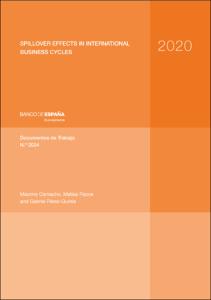Spillover effects in international business cycles
Autor
Fecha de publicación
10-nov-2020
Descripción física
48 p.
Resumen
Con el objetivo de analizar la transmisión de las fluctuaciones internacionales de los ciclos económicos, se propone un modelo de factores dinámicos multinivel con estructura de bloques en el que: i) no se restringe a los factores a ser ortogonales, y ii) se permite mezclar series de frecuencia mensual y trimestral. A través de simulaciones de Monte Carlo, se muestra la precisión en el cómputo de los factores no observados (teniendo en cuenta los efectos de transmisión) y en la estimación de los parámetros del modelo. El modelo propuesto se aplica a las economías del G-7. Por un lado, se analizan las respuestas de los factores nacionales a las perturbaciones originadas en los factores externos y, por otro, se cuantifica el cambio en la previsión de crecimiento del PIB nacional como consecuencia de incrementos inesperados en las previsiones de crecimiento del PIB del resto de los países. Si bien la proporción del factor global como fuente de transmisión de las fluctuaciones internacionales es significativa, esta es parcialmente absorbida por los efectos de transmisión. Además, se documenta un canal procíclico de la transmisión internacional de las expectativas de crecimiento del PIB, donde Estados Unidos y el Reino Unido son los países que producen el mayor efecto de derrame, y Alemania y Japón los que menores efectos de transmisión generan. Por todo ello, los responsables de políticas económicas debieran supervisar de cerca la evolución de las expectativas relacionadas con el desarrollo de los ciclos económicos externos.
To analyze the international transmission of business cycle fluctuations, we propose a new multilevel dynamic factor model with a block structure that (i) does not restrict the factors to being orthogonal and (ii) mixes data sampled at quarterly and monthly frequencies. By means of Monte Carlo simulations, we show the high performance of the model in computing inferences of the unobserved factors, accounting for the spillover effects, and estimating the model’s parameters. We apply our proposal to data from the G7 economies by analyzing the responses of national factors to shocks in foreign factors and by quantifying the changes in national GDP expectations in response to unexpected positive changes in foreign GDPs. Although the share of the world factor as a source of the international transmission of fluctuations is still signicant, this is partially absorbed by the spillover transmissions. In addition, we document a pro-cyclical channel of international transmission of output growth expectations, with the US and UK being the countries that generate the greatest spillovers and Germany and Japan being the countries that generate the smallest spillovers. Therefore, policymakers should closely monitor the evolution of foreign business cycle expectations.
To analyze the international transmission of business cycle fluctuations, we propose a new multilevel dynamic factor model with a block structure that (i) does not restrict the factors to being orthogonal and (ii) mixes data sampled at quarterly and monthly frequencies. By means of Monte Carlo simulations, we show the high performance of the model in computing inferences of the unobserved factors, accounting for the spillover effects, and estimating the model’s parameters. We apply our proposal to data from the G7 economies by analyzing the responses of national factors to shocks in foreign factors and by quantifying the changes in national GDP expectations in response to unexpected positive changes in foreign GDPs. Although the share of the world factor as a source of the international transmission of fluctuations is still signicant, this is partially absorbed by the spillover transmissions. In addition, we document a pro-cyclical channel of international transmission of output growth expectations, with the US and UK being the countries that generate the greatest spillovers and Germany and Japan being the countries that generate the smallest spillovers. Therefore, policymakers should closely monitor the evolution of foreign business cycle expectations.
Publicado en
Documentos de Trabajo / Banco de España, 2034
Materias
Ciclos económicos internacionales; Datos de frecuencia mixta; Estimación bayesiana; Efectos de derrame; International business cycles; Mixed frequency data; Bayesian estimation; Spillover effects; Fluctuaciones y ciclos económicos; Economía internacional
Aparece en las colecciones:












